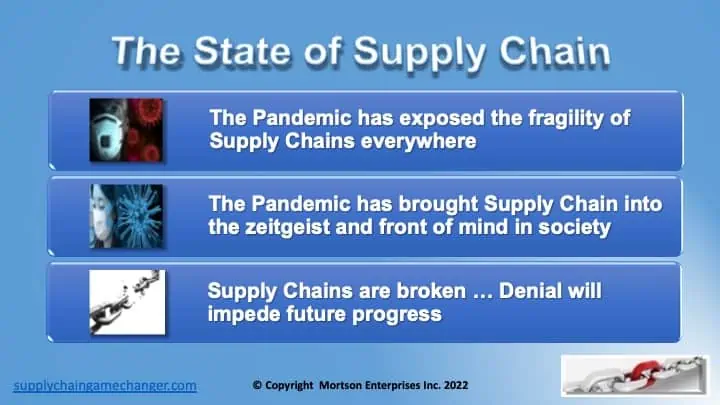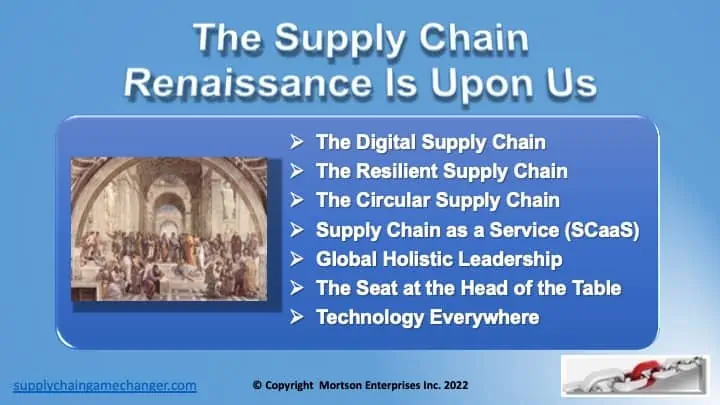With the relaxation of many of the protective pandemic protocols, more and more companies, institutions, and people are trying to get back to “normal”, or business as usual. However this is a moment of truth.
We can’t go back to business as usual. There have been too many disruptions in every aspect of our lives. The old ways of doing things, particularly in Supply Chain, have been exposed as contributing to these disruptions.
Still there are many who will conveniently forget the life changing experience we all have gone through with the pandemic, and this inertia will inhibit making the improvements necessary.
So will we move forward and make changes and improvements, or will we stagnate and remain stuck in the old ways? This is the most important Supply Chain question.
Supply Chain’s Moment of Truth has arrived!
The State of Supply Chain!

The Coronavirus Exposed the Fragility of Supply Chains in Virtually Every Industry
I remember in early 2020 going shopping and seeing people buying huge quantities of toilet paper and wondering what was going on. We were also searching masks and hand sanitizer, which were in short supply. Store shelves were empty of numerous basic household goods.
And the news was buzzing about shortages of ventilators and PPE (Personal Protective Equipment) for healthcare workers, those who were on the front lines of our battle with the Coronavirus.
Shortly thereafter everything shut down. People were working from home and normally traffic filled highways were empty. Manufacturing facilities and offices, stores and restaurants, and logistics operations were operating at nominal capacity levels if not closed outright.
Just-In-Time systems faltered. Single points of failure in the Supply Chain were exposed. Think about the Suez canal blockage as a case in point.
The level of disruption continued on from toilet paper, PPE and household goods to everything from lumber to fireworks to Christmas trees to semiconductors, automobiles and on and on and on.
Logistics delays were commonplace. Cargo ship loading and unloading at ports was severely backlogged. Truck driver and truck infrastructure shortages compounded the delays.
Company war rooms, shortage expediting, tweaking parameters, and safety stock upgrading were some of the actions that Supply Chain leaders took to try and get a handle on the disruptions. They dusted off old Disaster Recovery plans, which proved to be insufficient and inadequate at dealing with the new reality.
To make matters worse the stress and turmoil on workers in coping with the pandemic fallout resulted in burnout, resignations, inefficiency, and Post Pandemic Stress Disorder.
The pandemic exposed the fragility of Supply Chains everywhere, in every industry and in every geography. Supply Chain design had proven to be not nearly as robust and resilient as they needed to be, bringing us to this moment of truth.
The Pandemic Has Brought Supply Chain into the Zeitgeist
The term “Supply Chain Management” was first coined by Keith Oliver in 1982. Never before in the last 40 years have you heard “Supply Chain” used by so many Government leaders, Corporate leaders, Institutions, the Media, Schools children and anyone else in society for that matter.
Supply Chain’s profile has been raised by the pandemic and it is now top of mind for everyone. People how have historically viewed Supply Chain as merely a back office function should now appreciate that Supply Chain is actually the very engine that makes most companies, most economies, and much of our personal and professional lives, run.
The question is, will Supply Chain still be in the spotlight once we get past the pandemic?
With so much attention on, and awareness of, Supply Chain the time has never been better and the motivation never stronger to make the improvements need for the future and face our moment of truth.
But there is enough inertia, enough people who want to just go back to the old ways, and enough resistance to change, that this opportunity to make changes for the better could be squandered.
Supply Chains Are Broken … Denial Will Impede Making the Changes Needed to Make Improvements.
This is NOT just a planning issue. Waiting for good forecasting (if there is ever really such a thing as a good forecast) is a bad strategy. Supply Chains should be designed to handle forecast inaccuracies of all kinds.
Supply Chains must be more robust and more resilient. Think about all of the time and energy and money spent in dealing with issues, shortages, downtime, resources, process breakdowns, logistics delays and problems of every kind.
These breakdowns extend to virtually all functions in a company, all suppliers to a company, and all customers of a company. At its extreme companies have gone out of business, never to return, because of the failures of Supply Chain to adapt and to respond.
The lack of end to end, real time visibility has been chronic and it is a fundamental contributor to the state of disruption and the delay in, or lack of, responsiveness. It’s just like driving in a storm; if you can’t see out of the windshield you have no idea where you are, where you are going, or how you are going to get there.
Dismissing the fact that Supply Chains have been broken and being in denial is the single greatest problem for the future. Some will choose inaction over taking the bold and courageous and difficult steps needed to make things better in this moment of truth.
This recognition is important because there will always be another disaster. Whether natural or man made there will be some unpredictable disruptive event on the horizon. And while these disasters may be localized, and not as extensive as a global pandemic, they can bring your company to its knees just as easily.
Enablers and Disablers to the Present and Future States

What dynamics contributed to Supply Chain failures during the pandemic?
It is not conceivable that any Supply Chain, no matter how well designed and executed, could withstand the devastation caused by a global pandemic. But there are dynamics and realities which weakened, if not crippled, the ability of Supply Chains to respond better, faster and more nimbly.
And the danger is that, if unaddressed, these factors will cripple Supply Chains well into the future. Interestingly these dynamics are both enablers and disablers. Their absence leads to failures in Supply Chain performance whereas their presence maximizes the odds of survival, growth and success.
Visibility
Without the real time, electronic, end to end connectivity between a company’s customers, internal operations, suppliers (at all tiers), and service providers, the impact of the pandemic (or any disaster) is like trying to drive in whiteout conditions. It’s not possible.
An inability to see what is going on means that there is an inability to react and act, and make the quick decisions necessary to mitigate, if not avert, any disastrous consequences. Visibility is critically important.
Electronic Connectivity
It is no longer enough to be connected by phone or by emails. Most Supply Chains involve far too many parts, suppliers, customers, operations and processes to be connected manually.
Electronic connectivity is the foundation on which the Digital Supply Chain can be built with real time information. Without it we continue to live and operate in the Middle Ages.
Skills and Leadership
Far too many organizations have not recognized Supply Chain and its value, certainly prior to the pandemic. Supply Chain is THE engine that makes most companies run.
It touches virtually every function and every stakeholder, unlike any other group. Too many CEOs don’t understand this. And too many C-level Executives have no or limited Supply Chain experience and knowledge.
The earth shattering tremors of the pandemic required real leadership and overall business management skills, not just function specific skills. But did companies really make the investments necessary to hone and develop those skills?
The importance of Supply Chain talent, development, acquisition and retention has never been more apparent. This expertise is in high demand and supply is constrained.
Further the skills that are required to run a functional back office Supply Chain are much different than the skills and leadership capabilities that we will need in the future.
The ability to lead, envision, strategize, and implement the capabilities needed going forward rests on the shoulders of Supply Chain professionals. And the skills that are necessary to make this happen in the future are much different than the tactical and technical skills of the past:
- Strategic Planning and Big Thinking
- Applied Real Time End to End Supply Chain Expertise
- Technological Knowledge and Expertise
- Change Leadership
- Control Tower Leadership
- Data Analytics Mindset and Mentality
- Risk Management Expertise
- Holistic, Global Leadership
- Business Process Transformation Skills
- Best Practices Knowledge
Resilience and Robustness
How many companies even had Disaster recovery plans before the pandemic, let alone active plans that weren’t gathering dust in the deep recesses of drawers and cabinets?
The pandemic, and any other disruptive event, exposed too many single points of failure. Single sourcing, Low cost geography only sourcing, fragile processes and systems, lack of skills and management and leadership, lack of visibility to 2nd, 3rd and 4th tier suppliers, congested shipping ports, Total Cost of Ownership models focussed largely on price, lack of strategic inventories are some areas which make Supply Chains vulnerable.
You cannot rely on good, or accurate, forecasts. You cannot define responsiveness based solely on lead times. You cannot expect that excessive handling, storage and movement of goods is anything but wasteful.
Supply Chains must be designed to be much more robust and resilient. Do you need to establish parallel Supply Chains? Can you engineer your structure to be more lead time agnostic in its responsiveness? Can you eliminate unnecessary nodes and middlemen in your logistics network?
Disintermediation of Supply Chains and eliminating waste using a “Don’t Touch” paradigm can greatly simplify, and strengthen, Supply Chains. This is a core aspect in our moment of truth.
Inertia, Denial and the Resistance to Change
We will get past the pandemic. But like any other situation commanding change, there are those who will be in denial about the need for change and resist it, either passively or aggressively, at all costs.
This will be the single biggest determinant of future progress or stagnation and reversion to the old ways of doing things. Sacred cows, the status quo, and inertia are enormous blockers for change.
Change is hard. It takes the investment of time, money, conviction, and an unrelenting drive. The easy thing to do, is to do nothing. But doing nothing will make us even more vulnerable in the future. Still people will be either in denial about the need for change or they won’t have the resolve to make it happen.
This is why one of the most critical skills for Supply Chain professionals in the future is Change Leadership. Not Change Management, but Change Leadership. There is a difference and it is real.
Technology
We have an unprecedented suite of technologies available.
Blockchain, Artificial Intelligence, Augmented Reality, Virtual Reality, the Internet of Things (IoT), Big Data, Predictive Analytics, Machine Learning, Cloud Computing, Control Towers, 3D Printing, Robotics, Autonomous Vehicles, Drones, Cyber Security and more.
There will always be opportunities for further technological improvements. There will always be a ned for standards and standardization to reduce costs, make implementation easier, and mitigate the barriers to adoption.
But this technological suite constitutes the core of capabilities required to create the Digital Supply Chain, which is the future. This enables the visibility and electronic connectivity that we need and it enables the intellectual automation that will provide for better and more responsive decision making.
The inevitable barriers and hurdles still need to be overcome. The inclusion of these technologies in visions and strategies and the acceptance of and willingness to invest in this direction will be met with the usual suspects in resisting and denying the need to change.
Change Leadership
Nothing will happen without Change Leadership as we face our moment of truth. As we mentioned previously there are far too many people who will just go back to the old ways of doing things after the pandemic is over. No matter how serious their organization was impacted, their denial will be rampant.
It takes special skills to be a Change Leader. At its core you must be able and willing to change the very culture in order to embrace the changes that are needed. Some people will resist because of fear of the unknown. Some will resist because they just don’t want to change. Everyone however must be brought along to make these changes work and become sustainable.
Failure however is not an option. And a lot of companies failed, or will only go on as a shadow of what they used to be, because they are Supply Chain boiled frogs and refused to make the changes needed to survive and progress.
What Direction Do We Take?

Supply Chain is now at a cross roads. What direction do we take at our moment of truth? Our choices fall at two ends of the spectrum for action.
On the one hand there is the status quo. People and companies keep doing what they have always been doing. They plug along hoping for the best. If another catastrophe of any kind happens they will just try to keep things together and survive it all.
On the other hand there is what we call “The Supply Chain Renaissance“. Similar to what happened in the Middle Ages there is a confluence of many dynamics that are laying the groundwork that will redefine Supply Chain for decades and decades to come.
All of the enablers and disablers that we have discussed can be employed to either make the advances and realize the possibilities of the future, or they can be employed to keep things operating the ways they have always been.
Broken links in the Supply Chain, which have been pervasive during the pandemic, provide the opportunity to improve and strengthen Supply Chains, and should not be ignored or wished away. The reality is that once we get past the pandemic far too many people will have short memories and revert to the old ways.
Progressive, competitive and serious companies will make the improvements necessary to advance and strengthen their Supply Chains and create the Digital Supply Chain of the future. The will create and embrace a new normal.
This enormous decision on the future direction is upon us and it is THE moment of truth.
The Supply Chain Renaissance is Upon Us

The Supply Chain Renaissance is upon us.
“Renaissance” means “the period of European history between the 14th and 17th centuries when there was a new interest in science and in ancient art and literature especially in Italy”. The word also means “a situation or period of time when there is a new interest in something that has not been popular in a long time” or “a period of new growth or activity or rebirth”. This was effectively a moment of truth for our ancestors.
The pandemic has created the conditions for and is the catalyst for the Supply Chain Renaissance.
There are many conditions which must be coincident to create the ecosystem conducive to launching a Renaissance of any sort. The unrelenting, pervasive, and unforgiving disruption of Supply Chains in every company in every industry and in every country around the world is the motivation, the inspiration, and catalyst for change.
Along with the enablers and disablers that we have discussed, the dynamics which are necessary to ignite a Renaissance are:
- Massive failures in the current environment making the status quo untenable
- The creation and awareness of a level of advanced intellectual expertise
- Reduced resistance to change and a desire to get back to a more stable condition
- The availability of new technologies, or the tools to create new technologies
- Extensive communication, information sharing and cross-fertilization of ideas and techniques
- Resource availability to fuel and foster innovation and creativity
- Awareness and recognition by Governments, Industries, Individuals and Society of the need for change
On top of that there is an Art to Supply Chain Management. It is so much more than following the mechanics of doing the job. It requires visioning, creativity, the ability to think outside the box, innovation, bravery and courage. All traits of the great Renaissance leaders and change makers.
All of these conditions exist today , unlike ever before, and are enabling the choice of creating a Supply Chain Renaissance in this moment of truth. The elements which define what it means to be in the Supply Chain Renaissance are:
The Digital Supply Chain
- Electronic end to end connectivity enabling real time visibility and decision making along with the capabilities from all other technologies.
The Robust and Resilient Supply Chain
- Creating the strength of performance to more greatly withstand disruptions of any kind. Even Just In Time systems failed in their current form and can be improved.
The Circular Supply Chain
- Designing in sustainability and environmentally appropriateness to benefit the planet and all who live on it, for generations to come.
Supply Chain as a Service (SCaaS)
- Every person in every company does not need to be an expert. They can hire this expertise on an as needed basis to leverage the experience, systems, processes, and infrastructure associated with SCaaS firms.
Global, Holistic Leadership
- Leaders must be able to see across their entire end to end network and have the tools (eg Control Towers) and skills to make global, informed and intelligent decisions and risk management. This is far beyond the skills just needed to run a single aspect of Supply Chain.
The Seat at the Head of the Table
- Supply Chain leadership not only belongs in the Boardroom and at the C-level, but it often belongs at the head of the table. Given its importance, which many now understand, we should be seeing more Supply Chain experienced CEOs.
Technology Everywhere
- The suite of technological capabilities and options in unprecedented. There is always the need for standards, open sourcing, and improvements. But the solutions available enable creation and deployment of a Digital Supply Chain vision.
Conclusion
It has NEVER been a more exciting time to be in Supply Chain, now and for the foreseeable future.
The global need, the appetite for improvement and innovation, the universe of opportunity, the wealth of technological advancements, and the promise of a better future all make Supply Chain the place to be. Who knows what great and amazing things our Supply Chain professionals will accomplish.
Our future will unequivocally be shaped by the leaders of Supply Chain. Those who step up will be the stars of tomorrow. Those who revert back to their old ways will fall by the wayside and be forgotten by history.
The eyes of the world are upon us and history and time will judge whether Supply Chain stepped up to the challenge and began a new age, a Supply Chain Renaissance.
The time is now. The moment of truth has arrived.
Which direction will you take?

